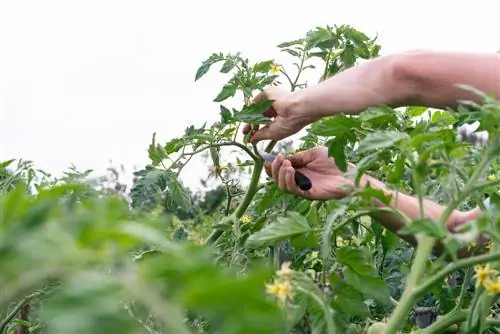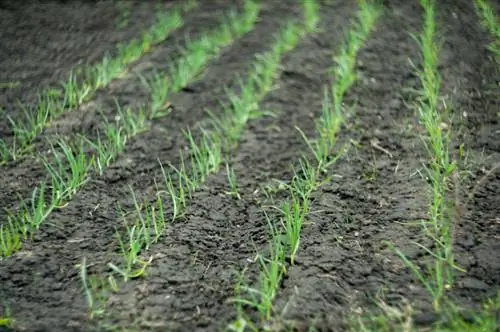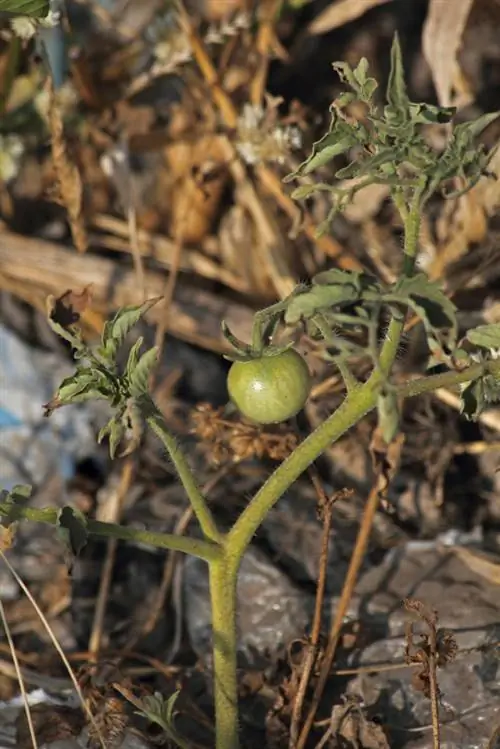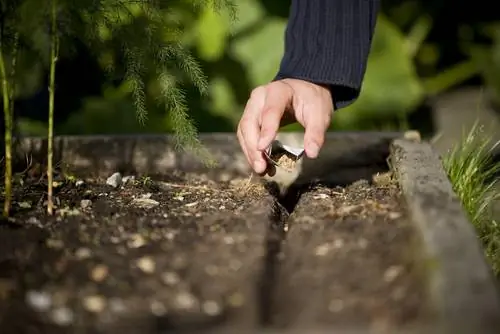- Author admin [email protected].
- Public 2023-12-29 04:51.
- Last modified 2025-06-01 06:02.
Pruning tomatoes (pruning) begins in June, when the plants have developed several pairs of leaves. Leaves close to the ground can also be cut off after planting. Later in the year, the tomato plant can be trimmed so that the fruit can fully develop before harvest.

Why and how do I prune tomato plants?
Cutting tomatoes provides ventilation, reduces disease and promotes fruit growth. Remove leaves close to the ground when planting, eliminate regular shoots during the growing season and cut off the main shoot in autumn to improve fruit ripening.
How to cut tomatoes?
When planting, the lower pairs of leaves close to the ground are removed in order to avoid the attack surface for pathogens from the ground. As growth progresses, stingy shoots - shoots between the main trunk and side shoots - can be removed regularly. At the end of the season in autumn, the top of the main shoot can be cut off so that the remaining fruits ripen. Not every type of tomato needs pruning. Bush and vine tomatoes as well as wild tomatoes require little to no pruning.
Instructions for cutting tomato plants
Pruning tomato plants is a complex topic that presents several hurdles for gardeners. What you should pay attention to when shortening the shoots and removing unwanted branches from tomato plants and what the requirements of the individual tomato varieties are is summarized below for you.
Cut shoots and limit their height
Pruning the tomato plant primarily serves to aerate the plant. If the vegetation is too dense, it inhibits the development and ripening of the fruit and also promotes possible disease infestation. Fungal spores in particular prefer habitats in which there is high humidity and dense vegetation.
In addition to a width limit, a height limit can also make sense. If planting outdoors between mid-May and early June, pruning should begin at the beginning of August at the latest.

In particular, the lower foliage, which is formed by the plant at the beginning of its growth cycle, can be removed from a height of one meter. Removing these up to a height of 25 to 35 centimeters is completely harmless and provides an additional growth spurt for the tomato. In addition, the branches in this area are particularly susceptible to fungal diseases, which are spread by splashing water, among other things.
In addition, you should shorten the main shoot of the shrub to the desired size when it reaches a size that is no longer manageable. In good conditions, stick tomatoes in particular can reach a height of up to 2 meters within a very short time. In addition, the existing shoots that grow out of the leaf axils should also be removed regularly.
Tip
Grow your tomato plants in the greenhouse, you can hang the plants. With the help of a string, the plants are lowered a little and thus have space to grow further upwards. Since tomatoes in the greenhouse can usually be harvested until November, there is enough time for new fruits to form.
Use the tomatoes
Removing the shoots growing out of the leaf axils is also known as pinching out. The shoots usually only have leaves and no inflorescences and by removing nutrients they inhibit the formation of buds on other side shoots. In addition, a large number of stingy shoots leads to an overall reduced growth rate and an increased susceptibility to fungal diseases. Further advantages of thinning are:
- better ventilation of the remaining shoots
- increased sun exposure of fruits
- reduced space requirement
- better stabilization of the plant thanks to a more open growth habit
- Use of the removed shoots as a raw material for fertilizer production
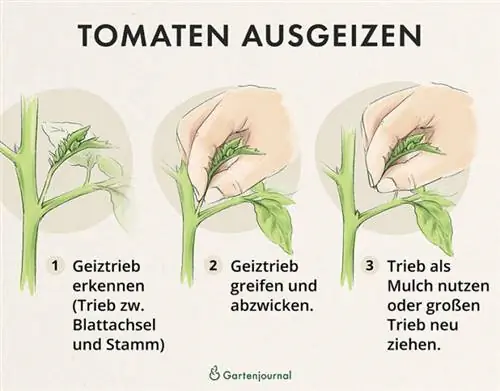
The process of stripping is simple and can be carried out without tools if carried out regularly. In practice, weekly maintenance from mid-June has become established in order to keep the care effort for the tomato plants within an acceptable range. The existing shoots are grasped at the point of origin using the thumb and index finger and carefully removed from the plant using the fingernails. For thicker shoots you can also use clean secateurs or a sharp knife, which are also placed as close as possible to the main shoot.
Pruning and thinning by variety
The requirements for pruning measures differ for the individual tomato varieties, which is why you should find out about the special features of the type you are growing before you prune for the first time. Basically, tomatoes can be divided into the genera of stick tomatoes, cocktail tomatoes, bush and vine tomatoes and wild tomatoes.
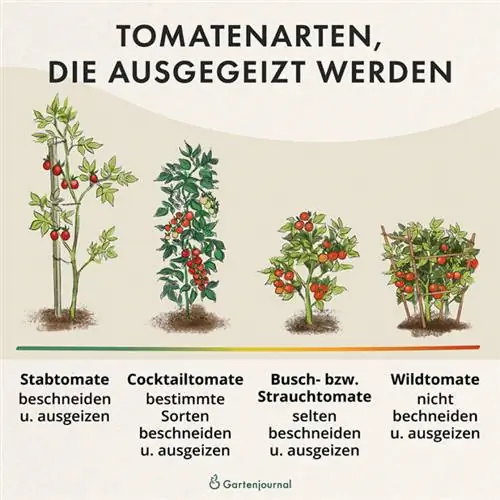
Stake tomato: The Stake tomato, which grows predominantly on a single shoot, requires both regular pruning in height and continuous thinning. In addition, thinning out widths is also recommended to ensure optimal ventilation and lighting of the shoots and fruits.
Cocktail tomato: The cocktail tomato, whose growth is already much bushier, should be pruned evenly in both height and width, similar to the stick tomato. Depending on the variety selected, removing the stingy shoots may not be absolutely necessary.
Bush tomatoes and vine tomatoes: In most cases, bush and vine tomatoes do not need pruning or thinning. In most cases, the plant punishes this with reduced growth and poor bud formation. However, since there can be differences between the individual varieties even within the classification, you should find out about the exact care requirements in advance.
Wild tomatoes: The wild tomatoes, which represent the most original growth form, should under no circumstances be pruned or thinned out. This subsequently leads to a lack of further growth and a reduction in crop yield.
You've never heard of the travel tomato? This article offers inspiration for the next gardening year.
Pruning tomatoes in autumn and winter
Pruning the tomatoes is also necessary in autumn and winter in order to be able to benefit from the plant for as long as possible. Especially in the event of overwintering, some instructions must be followed in order to make this successful.
Pruning in autumn
In this country, tomato plants grow until September orIf the weather is good, even into October. It is therefore advisable to start pruning the plant by mid-September at the latest. Removing shoots that have no flowers or fruit will encourage growth on the remaining branches. In addition, ventilation and lighting are increased, which contributes to better ripening of the fruits. At this point, pinching can also be stopped, as usually hardly any new shoots are created. Especially if you plan to overwinter the tomato plant, the stingy shoots should be left on the plant.
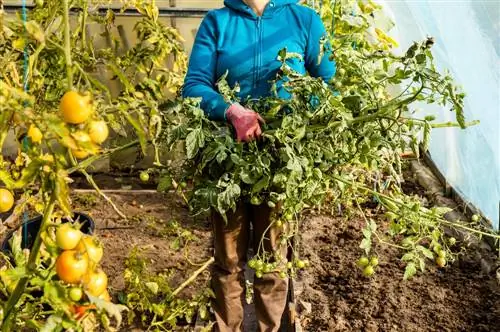
Before the tomato plants are completely removed from the bed, it is worth pruning generously to ensure that the fruits are fully ripe
Overwintering tomatoes
In principle, overwintering your tomato plants is also possible in this country. However, in order to meet the requirements of the nightshade plant, some measures must be taken:
- bright location with south orientation, if necessary use of a plant lamp for additional lighting
- Minimum temperature between 22 and 25 degrees Celsius
- moderate irrigation and fertilization during the winter months
- no pruning and no thinning
In addition, not all varieties are suitable for overwintering. In particular, species that can be assigned to the bush and vine tomatoes, as well as plants that are not diseased, survive the winter without any problems in a suitable location in the heated greenhouse or winter garden. You can find further tips and information about wintering here.
The three most common cutting mistakes
When it comes to pruning tomato plants, many mistakes still happen in practice that should be avoided at all costs for he althy plant growth and lush fruit selection.
Stake tomatoes never cut: Completely skipping pruning of a stake tomato leads to uncontrolled growth in height and width. In addition, the fruits that are formed often only have a small diameter, as the plant's main focus is on shoot growth. It is therefore advisable to cut back the plant continuously at an early stage and thin it out regularly.
Main shoots of bush tomatoes shortened: In most cases, shortening the main shoot of bush tomatoes responds to the plant with no further expansion in height and a reduced development of buds and fruits. To avoid this development, bush tomatoes should not be cut back.
Unclean scissors used:If unclean work materials are used, there is a risk of infection of the tomato plant because the pathogens gain direct access to the wound site. The use of a cutting tool is particularly recommended when harvesting beefsteak tomatoes, as they are often firmly overgrown. Therefore, make sure that your tools are thoroughly cleaned and disinfected regularly, even if the previously cut plant does not show any external symptoms illness shows.
FAQ
When should tomato plants be pruned?
If planted between May and June, the first pruning measures should be carried out at the beginning of August at the latest. However, if there is a corresponding increase in height, work can be done as early as July.
How to cut tomatoes?
The extent to which pruning of the tomato is necessary depends on the variety selected. While bush, vine and wild tomatoes do not need to be cut back, stick and cocktail tomatoes require regular thinning. The cutting is then done using secateurs or a sharp knife, which are placed on the leaf axil.
Can you shorten tomatoes in height?
Tomatoes can be shortened both in width and height. This is particularly recommended for tall-growing stick tomato varieties to make it easier to handle.
Can tomato plants be overwintered?
In principle, it is also possible to overwinter tomato plants in this country, although the winter quarters must be in a bright and warm place.

